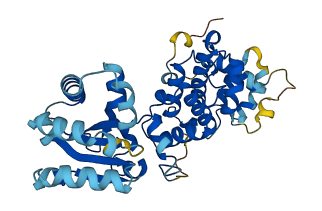Q9P3B1
Gene name |
SPAC1565.02c |
Protein name |
Putative Rho GTPase-activating protein C1565.02c |
Names |
|
Species |
Schizosaccharomyces pombe (strain 972 / ATCC 24843) (Fission yeast) |
KEGG Pathway |
spo:SPAC1565.02c |
EC number |
|
Protein Class |
RHO GTPASE-ACTIVATING PROTEIN 68F (PTHR45808) |

Descriptions
In Schizosaccharomyces pombe, the putative Rho GTPase-activating protein C1565.02c contains an N-terminal BCH domain and a C-terminal GAP domain and is required for maintaining cell shape and size. The β5-strand of the BCH domain plays a crucial role in the autoinhibition of the GAP domain. The deletion of the BCH domain leads to RhoGAP activation, which in turn leads to RhoA inactivation. The loss of autoinhibition also contributes to enhanced intermolecular interactions through the BCH domain.
Autoinhibitory domains (AIDs)
Target domain |
170-352 (RhoGAP domain) |
Relief mechanism |
Ligand binding |
Assay |
Deletion assay, Mutagenesis experiment, Structural analysis |
Accessory elements
No accessory elements
References
- Chichili VPR et al. (2021) "Structural basis for p50RhoGAP BCH domain-mediated regulation of Rho inactivation", Proceedings of the National Academy of Sciences of the United States of America, 118,
- Aguda AH et al. (2006) "The structural basis of actin interaction with multiple WH2/beta-thymosin motif-containing proteins", Structure (London, England : 1993), 14, 469-76
Autoinhibited structure

Activated structure

2 structures for Q9P3B1
| Entry ID | Method | Resolution | Chain | Position | Source |
|---|---|---|---|---|---|
| 7E0W | X-ray | 280 A | A/B/C/D | 2-156 | PDB |
| AF-Q9P3B1-F1 | Predicted | AlphaFoldDB |
8 variants for Q9P3B1
| Variant ID(s) | Position | Change | Description | Diseaes Association | Provenance |
|---|---|---|---|---|---|
| I_1293766_C_T | 13 | G>D | No | Jeffares_SNPs | |
| I_1293419_C_T | 108 | R>Q | No | Jeffares_SNPs | |
| I_1293402_C_T | 114 | A>T | No | Jeffares_SNPs | |
| I_1293189_C_T | 185 | G>S | No | Jeffares_SNPs | |
| I_1293184_C_T | 186 | M>I | No | Jeffares_SNPs | |
| I_1293033_G_A | 237 | H>Y | No | Jeffares_SNPs | |
| I_1292939_C_A | 268 | S>I | No | Jeffares_SNPs | |
| I_1292621_G_T | 374 | P>Q | No | Jeffares_SNPs |
No associated diseases with Q9P3B1
No regional properties for Q9P3B1
| Type | Name | Position | InterPro Accession |
|---|---|---|---|
| No domain, repeats, and functional sites for Q9P3B1 | |||
Functions
| Description | ||
|---|---|---|
| EC Number | ||
| Subcellular Localization |
|
|
| PANTHER Family | PTHR45808 | RHO GTPASE-ACTIVATING PROTEIN 68F |
| PANTHER Subfamily | PTHR45808:SF2 | RHO GTPASE-ACTIVATING PROTEIN 68F |
| PANTHER Protein Class | GTPase-activating protein | |
| PANTHER Pathway Category |
VEGF signaling pathway Rac Angiogenesis Rac Cytoskeletal regulation by Rho GTPase Rho GAPs PDGF signaling pathway Rho |
|
4 GO annotations of cellular component
| Name | Definition |
|---|---|
| cell cortex | The region of a cell that lies just beneath the plasma membrane and often, but not always, contains a network of actin filaments and associated proteins. |
| cell division site | The eventual plane of cell division (also known as cell cleavage or cytokinesis) in a dividing cell. In Eukaryotes, the cleavage apparatus, composed of septin structures and the actomyosin contractile ring, forms along this plane, and the mitotic, or meiotic, spindle is aligned perpendicular to the division plane. In bacteria, the cell division site is generally located at mid-cell and is the site at which the cytoskeletal structure, the Z-ring, assembles. |
| cytoplasm | The contents of a cell excluding the plasma membrane and nucleus, but including other subcellular structures. |
| Golgi apparatus | A membrane-bound cytoplasmic organelle of the endomembrane system that further processes the core oligosaccharides (e.g. N-glycans) added to proteins in the endoplasmic reticulum and packages them into membrane-bound vesicles. The Golgi apparatus operates at the intersection of the secretory, lysosomal, and endocytic pathways. |
2 GO annotations of molecular function
| Name | Definition |
|---|---|
| GTPase activator activity | Binds to and increases the activity of a GTPase, an enzyme that catalyzes the hydrolysis of GTP. |
| phospholipid transfer activity | Removes a phospholipid from a membrane or a monolayer lipid particle, transports it through the aqueous phase while protected in a hydrophobic pocket, and brings it to an acceptor membrane or lipid particle. |
2 GO annotations of biological process
| Name | Definition |
|---|---|
| intermembrane phospholipid transfer | The transport of phospholipids between membranes in which a phospholipid molecule is transported through an aqueous phase from the outer leaflet of a donor membrane to the outer leaflet of an acceptor membrane. |
| small GTPase mediated signal transduction | The series of molecular signals in which a small monomeric GTPase relays a signal. |
No homologous proteins in AiPD
| UniProt AC | Gene Name | Protein Name | Species | Evidence Code |
|---|---|---|---|---|
| No homologous proteins | ||||
| 10 | 20 | 30 | 40 | 50 | 60 |
| MEHDLERLCF | IGGYDNDNDK | VIVVVTKNLE | LFKKYDDINL | IKEAYNHVHK | LIQKDERYTA |
| 70 | 80 | 90 | 100 | 110 | 120 |
| VFFAHDSTVF | SYLGLSLKAY | YGMDYYLHKN | VKAVYVIHTD | WMSKVAIRTL | LSIASPKFTR |
| 130 | 140 | 150 | 160 | 170 | 180 |
| KFRYLNSISD | LNKYIPLSHL | KLPPIVYEFD | RNVEPAIFPS | NPSATSNFIF | PVQQWTRPPD |
| 190 | 200 | 210 | 220 | 230 | 240 |
| ALVEGMQVVS | KSLQTEGLFR | KSCSRKHLDI | VIELYDNGCM | VDLEAFGPIA | ACSLIKHLFR |
| 250 | 260 | 270 | 280 | 290 | 300 |
| SLPSPLFSAE | FLNGLTDHMD | SGIDYAVSLQ | KLIDASMDKN | SQKLARLIFS | LLYQITQHEQ |
| 310 | 320 | 330 | 340 | 350 | 360 |
| ENMMNAQNLA | LCIGPSFSKA | DNIAELMSMK | DKEYNPYCYF | LEYAILHWNT | LFANEENWDS |
| 370 | |||||
| YIPQDPTLLL | PKTP |